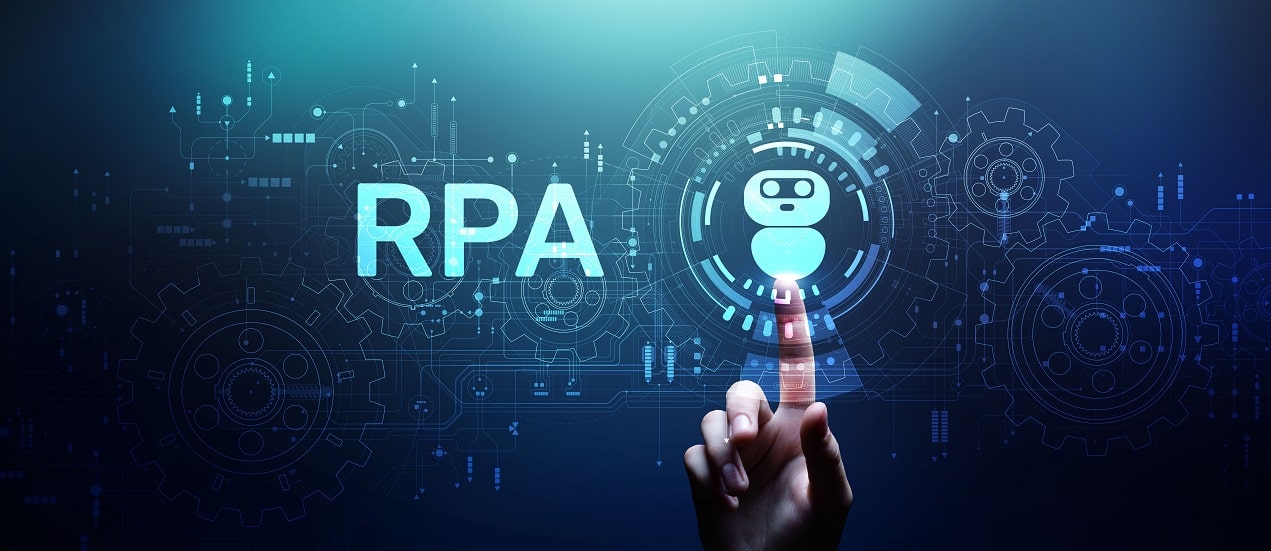Robotic Process Automation (RPA) is a form of business process automation technology based on metaphorical software robots (bots) or Artificial Intelligence (AI)/digital workers. As per a survey, RPA is one of the fastest-growing software segments, expected to grow at double-digit rates through 2024. Another study suggests that more than 90% of enterprises will have an automation architecture by 2025, up from less than 20% today! Amidst all this, another study shows that 50% of initial Robotic Process Automation projects fail to attain the expected ROI. Why does it happen and how can you avoid RPA project failures? Let’s find out!
What is Robotic Process Automation (RPA)?
Robotic Process Automation (RPA) is a software technology that mimics, learns, and executes human actions. The technology removes the reliance on a human workforce, decreases repetitive work, and creates an error-free operating environment that can run round the clock. RPA has also begun leveraging Artificial Intelligence (AI) and Machine Learning (ML) capabilities to automate complex and unstructured work.
In this blog, we will look at how to approach RPA implementations successfully and avoid potential failures.
%20(1).jpg?width=2250&name=IMG01%20(5)%20(1).jpg) Reasons to use RPA in banking
Reasons to use RPA in banking
The following image represents a typical payment processing flow chart in a bank. Let us see how we would approach each step of the end-to-end process from an automation perspective.
.jpg?width=2250&name=Img02%20(3).jpg)
Figure A: A typical payment processing flow chart in a bank
Process classifications for RPA releases:
Green: First phase, simple, standard input, fewer screens
Yellow: Second phase, moderate, varying inputs, fewer screens but more data points
Pink: Third phase, complex, need cognitive approach, complex business rules
There are some steps in Figure A like format identification (#1) and parameter extraction (#5), which RPA bots can handle easily. With their high frequency, these can be low-hanging fruits, and you can start getting results in shorter durations. Based on process assessments (details below), you can prioritize your processes into different release phases. Further, depending on user involvement, you can choose attended or unattended bots’ framework.
Once you see positive returns, you can begin with complex processes like Anti-Money Laundering (AML) and fraud detection. In these processes, you can use AI aspects of RPA, which are snowballing rapidly. Simultaneously, you can also work on the other processes which have standard inputs, such as fetching account information.
Banking needs robust compliance and audit regulations. Since every action of the bots can be traced using logs, RPA can help monitor and control your processes. You can create bots for automating compliance requirements to check manual errors and meet the audit expectations. The reconciliation and reporting processes can work without any human intervention.
%20(1).jpg?width=2250&name=Img03%20(2)%20(1).jpg)
Flowchart depicting reconciliation and reporting process in banks
Other possible RPA use cases in banking include:
- Customer onboarding
- AML and fraud management
- Payment reconciliation
- Risk and compliance operations
- Internal and external reporting
- Factoring and invoice discounting
- Trade clearing and settlement processes
- Credit card disputes
- Loan processing
Now broadly, there are two main phases before prioritizing (they can fail, if implemented incorrectly):
1. Feasibility assessment
Are you choosing the correct process and strategy for automation? To ensure that, use automation and check the technical and financial feasibilities. A proper feasibility check is essential since it will be critical for cascading work.
Automation feasibility
For automation, the process should follow certain guidelines like:
- Standardized inputs: It is crucial to standardize the inputs to the process with pre-defined values. The inputs must have a structure; automating unstructured data is difficult and has low confidence rates.
- Rule-based: This process should work on a rule-based system that can be coded. The exception rate should be low.
- Repetitiveness: The process can be repeated several times in a day, maintaining a frequency threshold so that the automation makes sense.
- Stability: If the process keeps changing frequently, it is not the best candidate for RPA as it will involve frequent development cycles.
Technical feasibility
Once the process passes the automation check, make sure you have the technical understanding to implement the workflows.
- Business logic: The complexity of business logic is directly proportional to the difficulty in automation. More decision points make the process more susceptible to issues. Therefore, it is essential to have a clear understanding of the logic. Prepare for any difficulties in the development phase by taking inputs from the development team.
- Type of application: Some legacy applications (like mainframes) and virtual applications (like Citrix) take time and expertise to automate. Therefore, you must examine all aspects of the process environment carefully during the opportunity assessment phase.
- Amount of screens/number of steps: It is better to have multiple automation points on a single screen than to have single contact points on numerous screens. When you move from one screen to the other means increased automation effort. The complexity of automation also increases with the number of steps in a multi-screen environment.
- Type of input: If you have invoices from different vendors in different formats, it won’t be easy to automate them. You might need technologies like OCR and computer vision, which are comparatively slower. Scanned images can also result in delayed automation. This makes it important to proactively devise a strategy for the diversification of inputs.
Financial feasibility
While working with RPA, you should know the timelines to realize its ROI. Due to implementation costs in the first year, you may not see immediate returns. While the initial investment is high, once you have the bots running in production, you will see greater returns. The involved costs will include:
- Development cost
- Tools licenses
- Trainings
- Support cost, etc.
2. ROI estimates
To calculate the expected return on your investments, you must first assess the current process holistically. When we automate the process, the general idea is to reduce operational costs and reduce time-to-market, i.e., increase delivery speed, and improve quality.
- Operational costs: When you calculate the current cost for Full-time Equivalent (FTE), you must include your current expenditure on your workforce (and future costs such as promotions), logistics costs, and infrastructure costs. Broadly, that includes all the costs (current and future) that you spend on the resources at work.
- Speed: Increase in the speed of the process (via bots) makes room for more work. This means you can get new revenue streams. Make sure you consider that aspect as well.
- Quality: When bots replace the human workforce, it leads to a drastic increase in quality, which means lesser bugs, reduced cost of rework, and increased customer satisfaction. Make sure your ROI captures these factors too.
Apart from all this, Regulatory Compliance and Data Governance, productivity gains, and business agility should also be part of your ROI calculations.
Incorrect ROI calculations project an incorrect picture to your sponsors, which can eventually defeat the whole purpose.
Seven useful tips for successful RPA implementations
1. Improve current processes
Automation on a simplified process multiplies your ROI. Use methodologies like Lean Six Sigma and Business Process Re-engineering. Spend time on current process improvements such as using web interfaces or chatbots for customer relations instead of phone calls to achieve end-to-end automation.
2. Be agile
Start with small processes where the automation check described above fits perfectly. After that, deliver to internal or external customers and use their feedback to work on comparatively large processes.
3. Reuse components
When you create a workflow for parameter extraction, you can store them in libraries. The workflows can be used by other processes like fetching account information. This structures the automation better and saves redundant effort.
4. Think holistically
RPA gives you end-to-end automation capabilities, i.e., you can do front-end automation like UI and leverage API automation. So, during AML and fraud process management, you can visit third-party sites or your back-end systems and use APIs to make the process quicker and error-free.
5. Choose alternative paths
When you create a workflow, you need to find other ways to do the same work. Choose the most efficient path, like instead of using “Get text” activities, use a much quicker approach like Regular expressions (Regex).
6. Make your processes secure
When you automate, you give your application access to bots. To avoid any security issues, guard your processes at the workflow level by using built-in security functionalities. Make sure your vendor complies with all the security regulations like GDPR.
7. Do hyper-automation
Once you start seeing the benefits, you can combine complementary technologies like AI, ML, Natural Language Processing (NLP), intelligent Optical Character Recognition (OCR), and computer vision to augment business processes. Using technologies like process and task mining, you can onboard every employee on this journey. Since creating a bot is just a drag and drop with LC/NC (low code/no code) approach, anyone can automate their daily, mundane tasks. Utilize community editions (which are free of cost) for such endeavors. Even an hour saved each day can result in big annual savings for the business. Since a bot can run 24 hours a day, productivity plays a pivotal role, which can only increase when you find opportunities everywhere.
Final thoughts
Before embarking on any new endeavor, we must strengthen our foundation. RPA is no different, we need to make sure the roots are strong, and then you can have as many branches as you want. The burden of fruits will never break them. In my experience with RPA implementations, I have seen if we follow the above pointers and guidelines scrupulously, the probability of success in RPA increases drastically.
Are you ready to “bank” on RPA? Do you have a use case in mind? We can help! Check out our offerings and get in touch with our experts.





